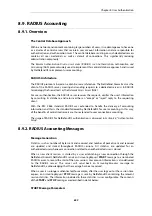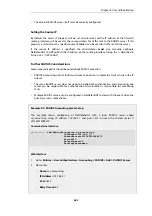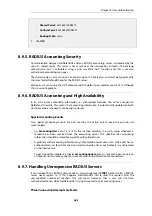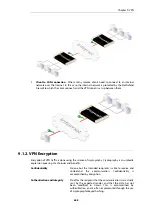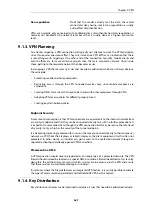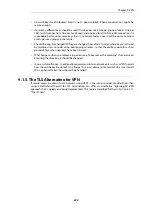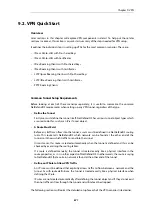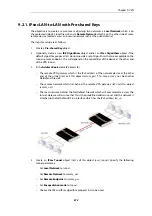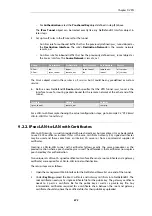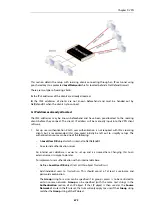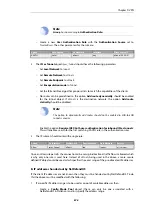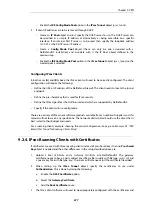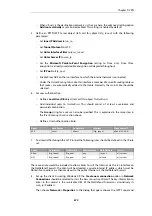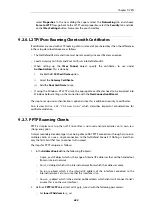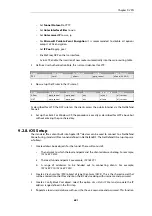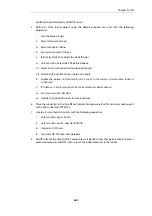
9.2. VPN Quick Start
Overview
Later sections in this chapter will explore VPN components in detail. To help put those later
sections in context, this section is a quick start summary of the steps needed for VPN setup.
It outlines the individual steps in setting up VPNs for the most common scenarios. These are:
•
IPsec LAN-to-LAN with Pre-shared Keys
•
IPsec LAN-to-LAN with Certificates
•
IPsec Roaming Clients with Pre-shared Keys
•
IPsec Roaming Clients with Certificates
•
L2TP/Ipsec Roaming Clients with Pre-Shared Keys
•
L2TP/IPsec Roaming Clients with Certificates
•
PPTP Roaming Clients
Common Tunnel Setup Requirements
Before looking at each of these scenarios separately, it is useful to summarize the common
NetDefendOS requirements when setting up any VPN tunnel, regardless of the type.
•
Define the Tunnel
Firstly we must define the tunnel itself. NetDefendOS has various tunnel object types which
are used to do this, such as an
IPsec Tunnel
object.
•
A Route Must Exist
Before any traffic can flow into the tunnel, a
route
must be defined in a NetDefendOS
routing
table
. This route tells NetDefendOS which network can be found at the other end of the
tunnel so it knows which traffic to send into the tunnel.
In most cases, this route is created automatically when the tunnel is defined and this can be
checked by examining the routing tables.
If a route is defined manually, the tunnel is treated exactly like a physical interface in the
route properties, as it is in other aspects of NetDefendOS. In other words, the route is saying
to NetDefendOS that a certain network is found at the other end of the tunnel.
•
Define an IP Rule to Allow VPN Traffic
An IP rule must be defined that explicitly allows traffic to flow between a network and the
tunnel. As with route definitions, the tunnel is treated exactly like a physical interface when
defining the IP rule.
IP rules are not created automatically after defining the tunnel object and if they do not exist
then no traffic can flow through the tunnel and will instead, be dropped.
The following sections will look at the detailed setup for each of the VPN scenarios listed earlier.
Chapter 9: VPN
671
Summary of Contents for NetDefendOS
Page 30: ...Figure 1 3 Packet Flow Schematic Part III Chapter 1 NetDefendOS Overview 30 ...
Page 32: ...Chapter 1 NetDefendOS Overview 32 ...
Page 144: ...Chapter 2 Management and Maintenance 144 ...
Page 284: ...Chapter 3 Fundamentals 284 ...
Page 392: ...Chapter 4 Routing 392 ...
Page 419: ... Host 2001 DB8 1 MAC 00 90 12 13 14 15 5 Click OK Chapter 5 DHCP Services 419 ...
Page 420: ...Chapter 5 DHCP Services 420 ...
Page 573: ...Chapter 6 Security Mechanisms 573 ...
Page 607: ...Chapter 7 Address Translation 607 ...
Page 666: ...Chapter 8 User Authentication 666 ...
Page 775: ...Chapter 9 VPN 775 ...
Page 819: ...Chapter 10 Traffic Management 819 ...
Page 842: ...Chapter 11 High Availability 842 ...
Page 866: ...Default Enabled Chapter 13 Advanced Settings 866 ...
Page 879: ...Chapter 13 Advanced Settings 879 ...



